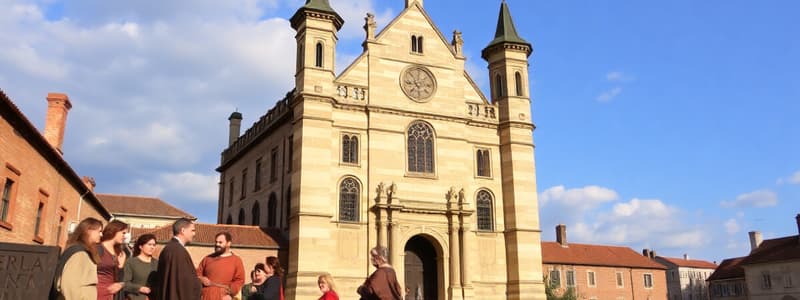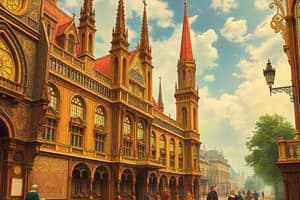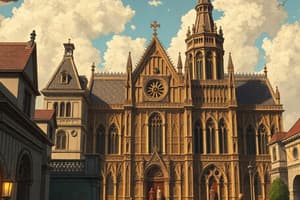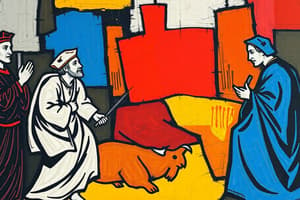Podcast
Questions and Answers
Which factor significantly contributed to the Renaissance in Italy?
Which factor significantly contributed to the Renaissance in Italy?
- A unified central government that promoted artistic expression.
- Thriving cities, a wealthy merchant class, and classical heritage. (correct)
- The decline of the merchant class due to constant warfare.
- The lack of access to classical texts and knowledge.
How did the bubonic plague in the 1300s contribute to the Renaissance?
How did the bubonic plague in the 1300s contribute to the Renaissance?
- It resulted in a labor shortage, allowing survivors to demand higher wages and pursue other interests like art. (correct)
- It led to a decline in trade and commerce, causing economic stagnation that spurred innovation.
- It increased the Church's authority and wealth, enabling them to become the primary patrons of the arts.
- It reinforced the importance of religious devotion and spiritual matters, reducing interest in worldly affairs.
In what way did Renaissance humanism influence art?
In what way did Renaissance humanism influence art?
- By leading artists to create works that criticized classical values and promoted medieval ideals.
- By promoting the use of abstract forms and non-representational styles in painting and sculpture.
- By inspiring artists to incorporate classical styles and realistic depictions of individuals. (correct)
- By encouraging artists to focus exclusively on religious themes and spiritual subjects.
What role did patrons of the arts play during the Renaissance?
What role did patrons of the arts play during the Renaissance?
How did Renaissance writers contribute to the changing trends in literature?
How did Renaissance writers contribute to the changing trends in literature?
Which statement best describes Machiavelli's perspective in The Prince?
Which statement best describes Machiavelli's perspective in The Prince?
What was a key difference between the Italian Renaissance and the Northern Renaissance?
What was a key difference between the Italian Renaissance and the Northern Renaissance?
What was the significance of the printing press invented by Johann Gutenberg?
What was the significance of the printing press invented by Johann Gutenberg?
What was the initial intention of Martin Luther in posting his 95 Theses?
What was the initial intention of Martin Luther in posting his 95 Theses?
What was the significance of the Peace of Augsburg (1555)?
What was the significance of the Peace of Augsburg (1555)?
How did the Reformation influence the political landscape of Europe?
How did the Reformation influence the political landscape of Europe?
What was the main goal of the Catholic Reformation (also known as the Counter-Reformation)?
What was the main goal of the Catholic Reformation (also known as the Counter-Reformation)?
What was the significance of the Council of Trent?
What was the significance of the Council of Trent?
Which of the following best describes the religious policy of Elizabeth I of England?
Which of the following best describes the religious policy of Elizabeth I of England?
How did the Renaissance contribute to the Scientific Revolution?
How did the Renaissance contribute to the Scientific Revolution?
Considering the impact of new technologies and ideas, what statement best reflects the long-term significance of the Renaissance and Reformation?
Considering the impact of new technologies and ideas, what statement best reflects the long-term significance of the Renaissance and Reformation?
How did humanism affect the art of the Renaissance?
How did humanism affect the art of the Renaissance?
What actions demonstrate Luther's defiance of the Catholic Church's authority?
What actions demonstrate Luther's defiance of the Catholic Church's authority?
How did the invention of the printing press affect people's ability to interpret scripture?
How did the invention of the printing press affect people's ability to interpret scripture?
What was the core belief of Anabaptists that distinguished them from other Protestant groups?
What was the core belief of Anabaptists that distinguished them from other Protestant groups?
How did the Council of Trent address the issues that sparked the Reformation?
How did the Council of Trent address the issues that sparked the Reformation?
What was the impact of city-states in Italy during the Renaissance?
What was the impact of city-states in Italy during the Renaissance?
How might the fact that Mainz was located on a river have helped the spread of printing?
How might the fact that Mainz was located on a river have helped the spread of printing?
Why might Machiavelli have thought it advantageous for a prince to be feared rather than loved?
Why might Machiavelli have thought it advantageous for a prince to be feared rather than loved?
What feature of Renaissance art allowed artists to add beauty and realism to their works?
What feature of Renaissance art allowed artists to add beauty and realism to their works?
What was a key factor that differentiates the Renaissance in Northern Europe from Italy?
What was a key factor that differentiates the Renaissance in Northern Europe from Italy?
How did the actions of the German printers affect the spread of the Renaissance?
How did the actions of the German printers affect the spread of the Renaissance?
How did the Christian Humanists view the role of the Church?
How did the Christian Humanists view the role of the Church?
What was the significance of the Elizabethan age?
What was the significance of the Elizabethan age?
What invention led to books being more readily available and more affordable?
What invention led to books being more readily available and more affordable?
What led to the decline in the Catholic Church's moral and political authority?
What led to the decline in the Catholic Church's moral and political authority?
What was a belief that John Calvin had?
What was a belief that John Calvin had?
What was Katherina Zell’s opinion on visiting those in quarantine?
What was Katherina Zell’s opinion on visiting those in quarantine?
What was the main goal of the Jesuits?
What was the main goal of the Jesuits?
Which choice was something that was agreed on at The Council of Trent?
Which choice was something that was agreed on at The Council of Trent?
How did the Northern Merchants react to the church?
How did the Northern Merchants react to the church?
Flashcards
What is the Renaissance?
What is the Renaissance?
A period of European history, from 1300 to 1600, that saw a rebirth of art and learning.
What is humanism?
What is humanism?
An intellectual movement that focused on human potential and achievements.
What does secular mean?
What does secular mean?
Worldly rather than spiritual and concerned with the here and now.
Who is a patron?
Who is a patron?
Signup and view all the flashcards
What is perspective in art?
What is perspective in art?
Signup and view all the flashcards
What is the vernacular?
What is the vernacular?
Signup and view all the flashcards
What is a utopia?
What is a utopia?
Signup and view all the flashcards
What is an indulgence?
What is an indulgence?
Signup and view all the flashcards
What is the Reformation?
What is the Reformation?
Signup and view all the flashcards
Who are Protestants?
Who are Protestants?
Signup and view all the flashcards
What is a papal bull?
What is a papal bull?
Signup and view all the flashcards
What does annul mean?
What does annul mean?
Signup and view all the flashcards
What is Protestantism?
What is Protestantism?
Signup and view all the flashcards
What is predestination?
What is predestination?
Signup and view all the flashcards
What is a theocracy?
What is a theocracy?
Signup and view all the flashcards
Who are the Jesuits?
Who are the Jesuits?
Signup and view all the flashcards
What is the Protestant Reformation?
What is the Protestant Reformation?
Signup and view all the flashcards
How did trade and manuscripts impact Europe?
How did trade and manuscripts impact Europe?
Signup and view all the flashcards
Who started the Reformation?
Who started the Reformation?
Signup and view all the flashcards
How did the printing press revolutionize Europe?
How did the printing press revolutionize Europe?
Signup and view all the flashcards
How did art reflect the importance of individuals?
How did art reflect the importance of individuals?
Signup and view all the flashcards
Did Renaissance artist focus on the group or the individual?
Did Renaissance artist focus on the group or the individual?
Signup and view all the flashcards
What subjects are humanities?
What subjects are humanities?
Signup and view all the flashcards
How did people achieve salvation?
How did people achieve salvation?
Signup and view all the flashcards
How did the bible become more important?
How did the bible become more important?
Signup and view all the flashcards
What was the legacy of The Renaissance?
What was the legacy of The Renaissance?
Signup and view all the flashcards
Study Notes
European Renaissance and Reformation (1300–1600)
- This era brought major changes in European social and cultural life.
Cultural Interaction
- Trade with the East and the rediscovery of ancient manuscripts spurred new ideas about culture and art.
- The Renaissance, meaning rebirth, is the name given to this time
Religious and Ethical Systems
- Martin Luther initiated the Reformation, aiming to reform perceived wrongs in the Catholic Church.
- This led to the establishment of non-Catholic churches.
- Wittenberg is where the Reformation began.
Revolution
- The printing press enabled faster and cheaper production of books and pamphlets.
- This technology facilitated the spread of Renaissance and Reformation ideas.
- Printing spread from Mainz.
Jan van Eyck's "The Madonna of Chancellor Rolin" (c. 1435)
- The columns indicate use of classical art styles.
- The technique of perspective is used, and oil paints were a new invention at the time.
- The painting shows the continuing importance of Christian religion.
- The fur-trimmed robe Chancellor Rolin is wearing shows his status.
- Many details were added solely for beauty, such as the floor design, Mary's cloak, scene outside, etc.
Renaissance Origins in Italy
- The Renaissance, an explosion of creativity, spanned roughly 1300 to 1600.
- It signifies a rebirth, specifically a revival of art and learning.
- Educated Italians aimed to revive classical Greek and Roman culture, but developed new styles leading to innovative art, literature, and values like individualism.
- The Renaissance later extended from northern Italy to the rest of Europe based on cities, a wealthy merchant class, and classical heritage.
City-States
- Overseas commerce from the Crusades fostered large city-states in northern Italy with sizable towns, were urban while the rest of Europe was rural.
- Cities facilitated intellectual exchange, making them ideal for intellectual revolutions.
Plague Impact
- Bubonic plague devastated cities in the 1300s, with up to 60% mortality.
- Labor shortages empowered survivors to demand higher wages.
- Merchants, with limited business opportunities, pursued art.
Merchants and the Medici
- Wealthy merchant classes arose in Italian city-states.
- Political engagement was high due to the relatively small size of city-states like Milan and Florence.
- Merchants, unlike nobles, earned their status through wit, valuing individual achievement.
- Florence had a republican government in the late 1200s.
- The Medici family, a powerful banking dynasty, controlled Florence during the Renaissance without seeking official titles.
Cosimo de Medici
- Cosimo de Medici, the wealthiest European of his time, gained control of Florence's government in 1434 by influencing council members through loans and was essentially the dictator of Florence for 30 years.
Lorenzo de Medici
- Lorenzo de Medici, Cosimo's grandson, ruled Florence as a dictator from 1469, maintaining the facade of an elected government and was known as Lorenzo the Magnificent.
Revival of Greek and Roman Learning
- Renaissance scholars dismissed Middle Ages art and literature, desiring a return to Greek and Roman learning.
- Inspiration was drawn from the ruins of Rome, ancient Latin manuscripts in monasteries and Christian scholars fleeing to Rome with Greek texts after the Turks conquered Constantinople in 1453.
Classical and Worldly Values
- The study of classical texts led to humanism
- Humanism is an intellectual movement emphasizing human potential and achievements.
- Humanists utilized classical texts to understand ancient Greek values, influencing artists, architects, and promoting subjects like history, literature, and philosophy (the humanities).
- Humanists believed in enjoying life without offense to God, leading to the wealthy indulging in luxuries.
- Renaissance society was secular concerned with the here and now. Even church leaders became worldly, living in mansions and indulging in lavish lifestyles.
Patrons of the Arts
- Church leaders and wealthy families, such as the Medici, became patrons of the arts, financially supporting artists.
- Wealthy individuals displayed importance through portraits and public art donations.
The Renaissance Person
- Renaissance writers popularized the concept that all educated individuals should create art, striving to excel in diverse fields.
- Baldassare Castiglione's The Courtier (1528) outlined how to become a "universal man". This included being charming, witty, educated in classics, skilled in arts, and physically adept.
The Renaissance Woman
- The Courtier suggests upper-class women should be charming and knowledgeable in classics, but not seek fame, they should inspire, not create, were better educated than medieval women, but had limited political influence.
- Some women, like Isabella d’Este, exerted power as rulers and art patrons, excelling in politics and defense.
Renaissance Art Revolution
- Artists were supported by patrons like Isabella d’Este.
- Artistic styles shifted from medieval religious themes to realistic portrayals inspired by classical models.
- Perspective was used to show three dimensions on flat surfaces.
Realistic individuals
- Painters started creating portraits of individuals realistically.
- Michelangelo used realism to depict the human form.
- Donatello's sculptures were more realistic showcasing natural postures and expressions.
- His statue of David was the first large, free-standing nude sculpture since ancient times.
Leonardo da Vinci (1452–1519)
- Da Vinci was a painter, sculptor, inventor, and scientist.
- He was interested in how things work leading to observations and findings in his art.
- The Mona Lisa is one of the best-known portraits.
- The Last Supper depicts Jesus' disciples through facial expressions.
Raphael Sanzio (1483-1520)
- Raphael was younger than Michelangelo and Leonardo and was influenced by them
- A painter who portrayed gentle and calm expressions, known for his use of perspective.
- His masterpiece was filling Pope Julius II's library with paintings, including The School of Athens.
- Raphael painted Renaissance figures, such as Michelangelo and Leonardo, as classical philosophers.
Female Artists
- Sofonisba Anguissola was the first woman artist to gain international recognition, renowned for portraits.
- Artemisia Gentileschi trained with her father and painted strong, heroic women.
Renaissance Literature
- Renaissance writers used vernacular language for self-expression and character portrayal
- Francesco Petrarch (1304-1374) an early and influential humanist is considered the father of Renaissance humanism.
- Giovanni Boccaccio is known for The Decameron, realistic stories using humor to illustrate the human condition.
- Niccolò Machiavelli's The Prince (1513) examines imperfect human conduct of rulers, arguing a prince must be strong/shrewd, and prioritize political effectiveness over morality.
Women's Contributions
- Vittoria Colonna (1492–1547), wrote poems on personal subjects and exchanged sonnets with Michelangelo.
- The Renaissance had a strong impact of the arts and learning.
The Northern Renaissance
- Renaissance ideas, emphasizing individuality, spread to Northern Europe by the late 1400s. This includes England, France, Germany, and Flanders.
- The population grew after the bubonic plague and the Hundred Years' War, urban merchants became patrons of artists.
- Unlike divided Italy, the Monarchs of countries like England and France often sponsored arts, examples include Francis I of France, who invited Leonardo da Vinci and hired Italian artists to rebuild his castle.
- Northern Renaissance art was characterized by realism and a blend of Judeo-Christian values.
German Painters
- Albrecht Dürer (1471-1528) traveled to Italy and produced woodcuts, engravings of religious subjects, and landscapes, influencing art with realism.
- Hans Holbein the Younger (c. 1497-1543) painted photographic-style portraits.
Flemish Painters
- Flanders became an artistic center supported by wealthy merchants.
- Jan van Eyck (c. 1390-1441) used oil-based paints realistically.
- Pieter Bruegel the Elder (c. 1525-1569) portrayed peasant life with rich colors, vivid details, and balanced use of space.
Northern Writers and Reform
- Northern humanists scrutinized the Christian Church that then inspired Christian humanism to reform society.
- They focused on the importance of education.
- Desiderius Erasmus (c. 1466-1536) in The Praise of Folly, criticized various people and emphasizing studying the Bible.
- Thomas More (1478-1535) wrote Utopia, which outlines an ideally moral society with little use for money.
- Christine de Pizan (c. 1364-1430), challenged male views on educating women.
The Elizabethan Age
- The mid-1500s is when the Renaissance spread to England which was called the Elizabethan Age.
- Queen Elizabeth I (1533-1603) supported English art and literature.
- William Shakespeare (1564-1616) drew on the classics for works displaying the human condition.
Printing Revolution
- The Chinese invented block printing; Bi Sheng invented movable type around 1045.
- Johann Gutenberg in Germany developed a printing press around 1440 that enabled faster, cheaper book production, his complete Bible in 1455 was the first full-sized book with movable type.
- More accessible, affordable books greatly increased access to information
- Early books primarily religious, but later expanded to travel guides and medical manuals.
Global Impact
- The printing press combined technologies from Europe and Asia.
Legacy of the Renaissance
- The Dignity of the individual played a key role in the rise of democratic ideals
- Art techniques drew on Greece and Rome.
- Realistic and Lifelike paintings.
- The Arts praised the achievements of individuals.
Societal Change
- Printing made information more wide spread.
- There was an increased desire for learning, and legal proceedings became easier to understand.
- People started to question religion.
Luther Leads the Reformation
- The religious, social, and political effects set the stage for the modern world.
- It ended the Christian Unity of Europe and left it culturally divided.
- The Renaissance emphasis on individualism challenged Church authority
Studying That Suits You
Use AI to generate personalized quizzes and flashcards to suit your learning preferences.




